Abstract
Opportunistic infections caused by Candida tropicalis have been noted with increasing frequency in compromised patients. The pathogenicity of three isolates of C. tropicalis was studied in normal CD-1 mice, streptozotocin-induced diabetic mice, and cyclophosphamide-induced neutropenic mice. Lethal dose 50% endpoints and quantitative distribution of yeast cells in spleen, liver, and kidneys of mice infected intravenously were determined. The virulence of one yeast isolate was greater than that of the other two. The order of susceptibility to mortality and degree of organ colonization was neutropenic greater than diabetic greater than normal. Renal lesions resembling those associated with infection by C. albicans appeared by day 5 postinfection in diabetic and neutropenic mice. Greater numbers of C. tropicalis yeast cells were isolated from homogenates of the affected kidneys, suggesting that the kidney is a target organ for this fungus. This study demonstrates the increased susceptibility of compromised mice to C. tropicalis as compared with normal mice and verifies the ability of these yeasts to cause opportunistic disease.
Full text
PDF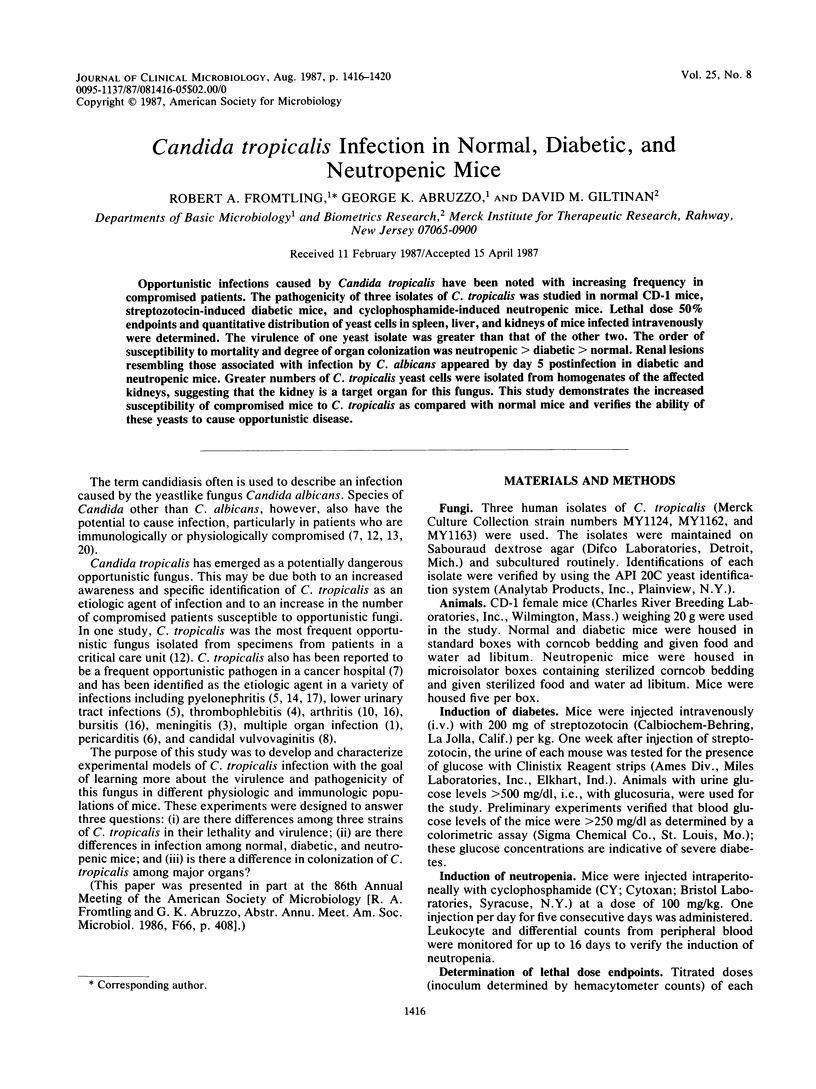
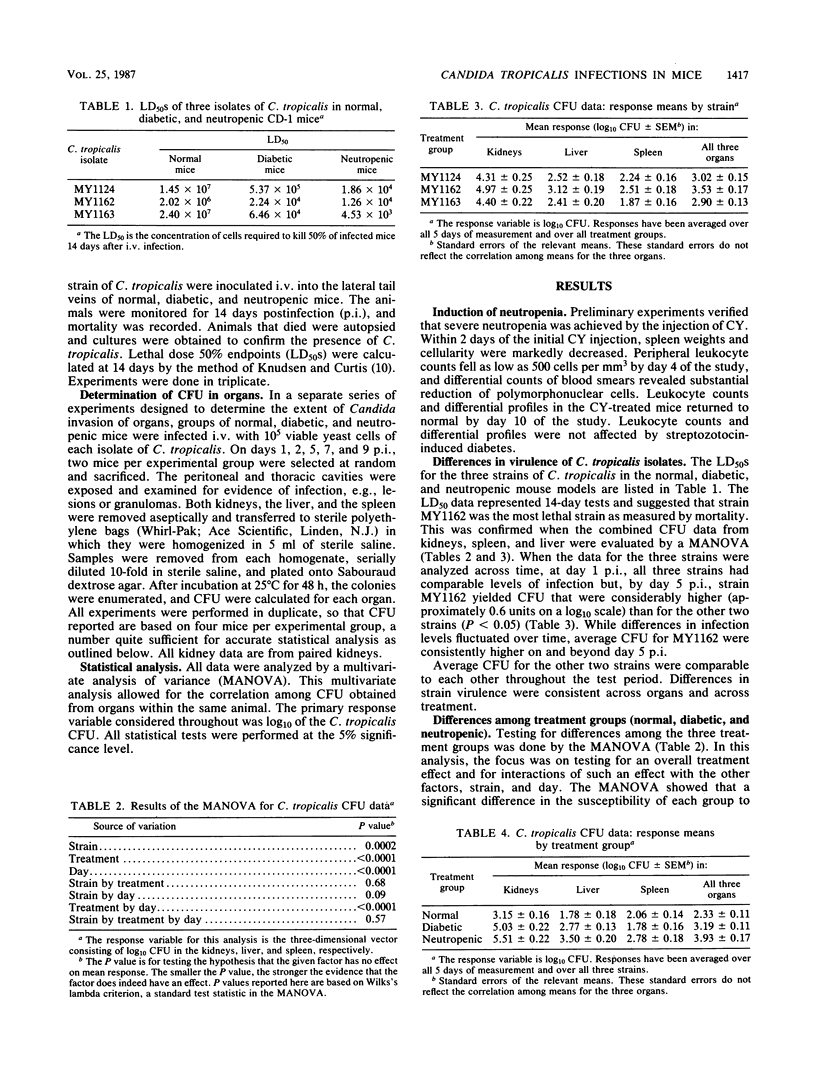
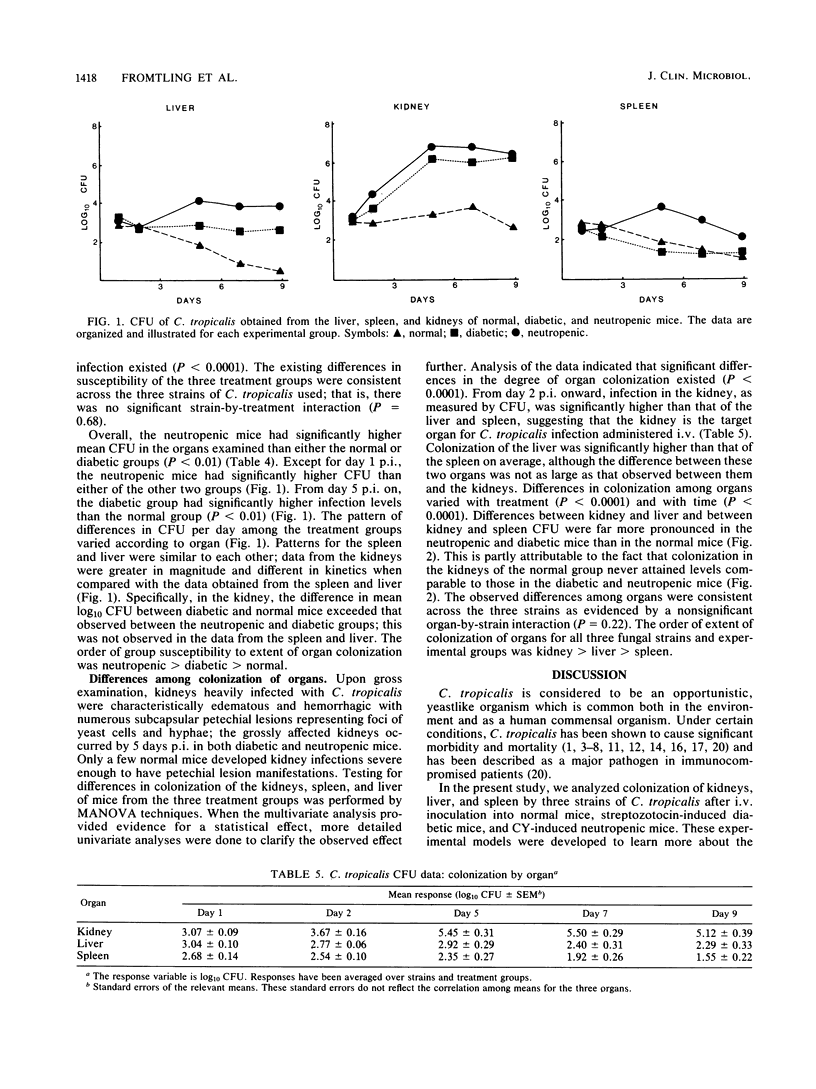
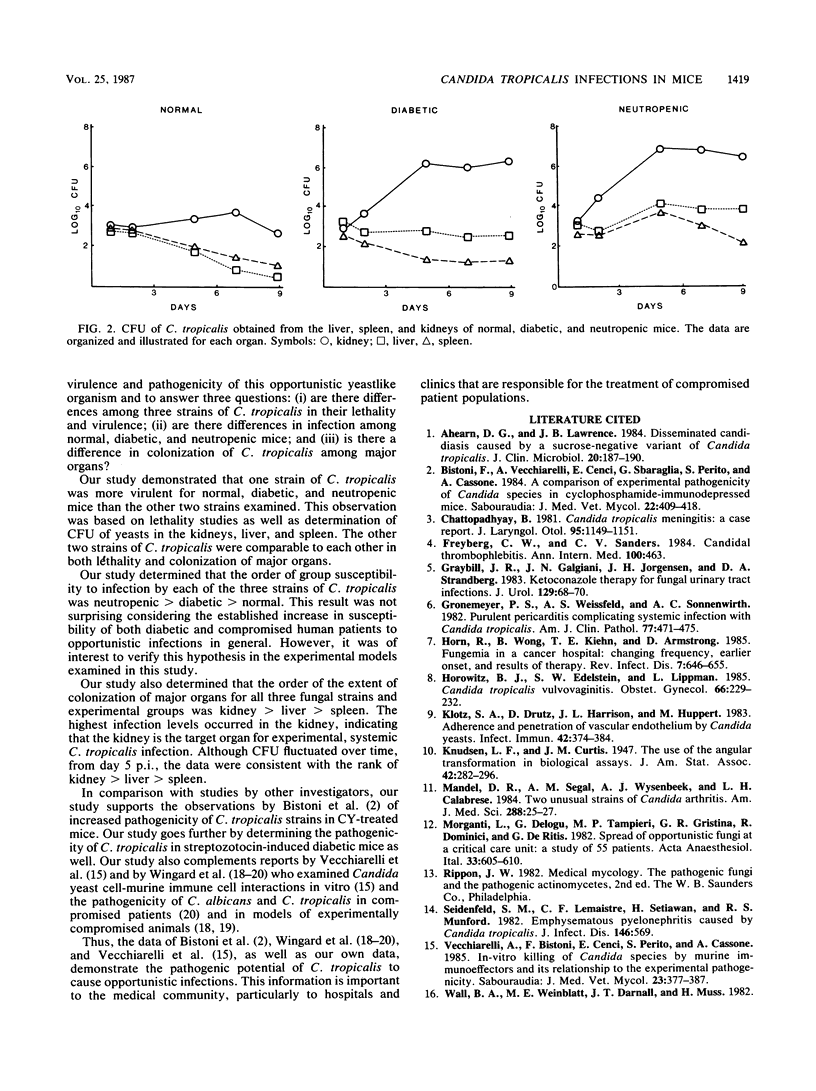
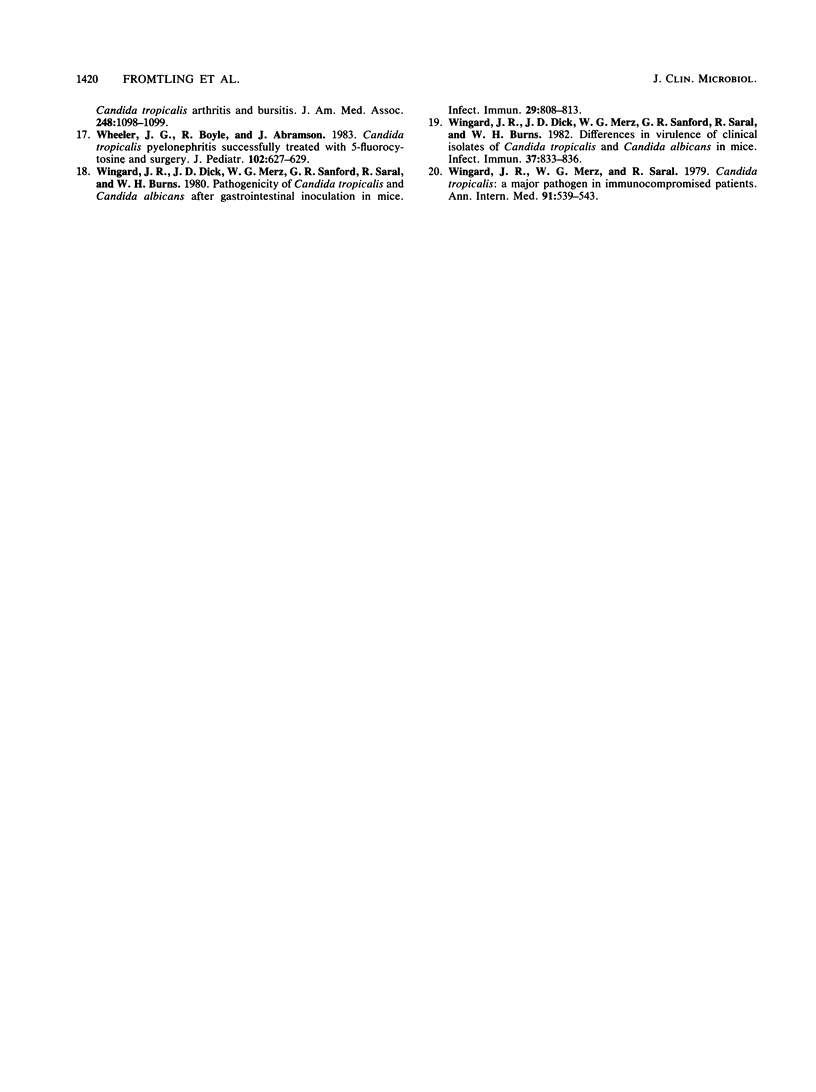
Selected References
These references are in PubMed. This may not be the complete list of references from this article.
- Ahearn D. G., Lawrence J. B. Disseminated candidiasis caused by a sucrose-negative variant of Candida tropicalis. J Clin Microbiol. 1984 Aug;20(2):187–190. doi: 10.1128/jcm.20.2.187-190.1984. [DOI] [PMC free article] [PubMed] [Google Scholar]
- Bistoni F., Vecchiarelli A., Cenci E., Sbaraglia G., Perito S., Cassone A. A comparison of experimental pathogenicity of Candida species in cyclophosphamide-immunodepressed mice. Sabouraudia. 1984;22(5):409–418. doi: 10.1080/00362178485380661. [DOI] [PubMed] [Google Scholar]
- Chattopadhyay B. Candida tropicalis meningitis: a case report. J Laryngol Otol. 1981 Nov;95(11):1149–1151. doi: 10.1017/s0022215100091933. [DOI] [PubMed] [Google Scholar]
- Freyberg C. W., Sanders C. V. Candidal thrombophlebitis. Ann Intern Med. 1984 Mar;100(3):463–463. doi: 10.7326/0003-4819-100-3-463_2. [DOI] [PubMed] [Google Scholar]
- Graybill J. R., Galgiani J. N., Jorgensen J. H., Strandberg D. A. Ketoconazole therapy for fungal urinary tract infections. J Urol. 1983 Jan;129(1):68–70. doi: 10.1016/s0022-5347(17)51922-9. [DOI] [PubMed] [Google Scholar]
- Gronemeyer P. S., Weissfeld A. S., Sonnenwirth A. C. Purulent pericarditis complicating systemic infection with Candida tropicalis. Am J Clin Pathol. 1982 Apr;77(4):471–475. doi: 10.1093/ajcp/77.4.471. [DOI] [PubMed] [Google Scholar]
- Horn R., Wong B., Kiehn T. E., Armstrong D. Fungemia in a cancer hospital: changing frequency, earlier onset, and results of therapy. Rev Infect Dis. 1985 Sep-Oct;7(5):646–655. doi: 10.1093/clinids/7.5.646. [DOI] [PubMed] [Google Scholar]
- Horowitz B. J., Edelstein S. W., Lippman L. Candida tropicalis vulvovaginitis. Obstet Gynecol. 1985 Aug;66(2):229–232. [PubMed] [Google Scholar]
- Klotz S. A., Drutz D. J., Harrison J. L., Huppert M. Adherence and penetration of vascular endothelium by Candida yeasts. Infect Immun. 1983 Oct;42(1):374–384. doi: 10.1128/iai.42.1.374-384.1983. [DOI] [PMC free article] [PubMed] [Google Scholar]
- Mandel D. R., Segal A. M., Wysenbeek A. J., Calabrese L. H. Two unusual strains of Candida arthritis. Am J Med Sci. 1984 Jul-Aug;288(1):25–27. doi: 10.1097/00000441-198407000-00005. [DOI] [PubMed] [Google Scholar]
- Seidenfeld S. M., Lemaistre C. F., Setiawan H., Munford R. S. Emphysematous pyelonephritis caused by Candida tropicalis. J Infect Dis. 1982 Oct;146(4):569–569. doi: 10.1093/infdis/146.4.569. [DOI] [PubMed] [Google Scholar]
- Vecchiarelli A., Bistoni F., Cenci E., Perito S., Cassone A. In-vitro killing of Candida species by murine immunoeffectors and its relationship to the experimental pathogenicity. Sabouraudia. 1985 Oct;23(5):377–387. doi: 10.1080/00362178585380541. [DOI] [PubMed] [Google Scholar]
- Wheeler J. G., Boyle R., Abramson J. Candida tropicalis pyelonephritis successfully treated with 5-fluorocytosine and surgery. J Pediatr. 1983 Apr;102(4):627–629. doi: 10.1016/s0022-3476(83)80208-x. [DOI] [PubMed] [Google Scholar]
- Wingard J. R., Dick J. D., Merz W. G., Sandford G. R., Saral R., Burns W. H. Differences in virulence of clinical isolates of Candida tropicalis and Candida albicans in mice. Infect Immun. 1982 Aug;37(2):833–836. doi: 10.1128/iai.37.2.833-836.1982. [DOI] [PMC free article] [PubMed] [Google Scholar]
- Wingard J. R., Dick J. D., Merz W. G., Sandford G. R., Saral R., Burns W. H. Pathogenicity of Candida tropicalis and Candida albicans after gastrointestinal inoculation in mice. Infect Immun. 1980 Aug;29(2):808–813. doi: 10.1128/iai.29.2.808-813.1980. [DOI] [PMC free article] [PubMed] [Google Scholar]
- Wingard J. R., Merz W. G., Saral R. Candida tropicalis: a major pathogen in immunocompromised patients. Ann Intern Med. 1979 Oct;91(4):539–543. doi: 10.7326/0003-4819-91-4-539. [DOI] [PubMed] [Google Scholar]


